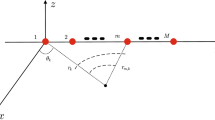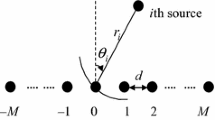Abstract
This paper is concerned with source localization when path loss is taken into account. We modify multiple signal classification method to localize near-field sources whose received power is different in the sensors of the array due to path loss. Traditional methods fail to localize the sources, and they also fail to separate the bearing estimation and the range estimation of the sources, when path loss is considered. We suggest a T-shaped array avoiding multidimensional search to estimate source location parameters, separately. At the first step, the ranges of the signal sources are estimated, and then at the second step, the directions of arrival of the sources are estimated using the respective ranges determined at the first stage. The performance of the proposed method is assessed when mixed near-field and far-field sources coexist. Simulation results are presented to show the superior performance of the proposed algorithm compared to the existing techniques and the Cramer–Rao bound.









Similar content being viewed by others
References
Behmandpoor, P., & Haddadi, F. (2019). Near-field coherent source localization by planar array design. Multidimensional Systems and Signal Processing,30(1), 219–237.
Challa, R. N., & Shamsunder, S. (1995, October). High-order subspace-based algorithms for passive localization of near-field sources. In 1995 conference record of the twenty-ninth Asilomar conference on signals, systems and computers (Vol. 2, pp. 777–781). IEEE.
Chen, H., Zhu, W. P., Liu, W., Swamy, M. N. S., Li, Y., Wang, Q., et al. (2019). RARE-based localization for mixed near-field and far-field rectilinear sources. Digital Signal Processing,85, 54–61.
Grosicki, E., Abed-Meraim, K., & Hua, Y. (2005). A weighted linear prediction method for near-field source localization. IEEE Transactions on Signal Processing,53(10), 3651–3660.
Gu, J. F., Zhu, W. P., & Swamy, M. N. S. (2015). Joint 2-D DOA estimation via sparse L-shaped array. IEEE Transactions on Signal Processing,63(5), 1171–1182.
He, J., Swamy, M. N. S., & Ahmad, M. O. (2012). Efficient application of MUSIC algorithm under the coexistence of far-field and near-field sources. IEEE Transactions on Signal Processing,60(4), 2066–2070.
Huang, Y. D., & Barkat, M. (1991). Near-field multiple source localization by passive sensor array. IEEE Transactions on Antennas and Propagation,39(7), 968–975.
Huang, H., Liao, B., Guo, X., & Huang, J. (2018). DOA estimation of rectilinear signals with a partly calibrated uniform linear array. Signal Processing,147, 203–207.
Hung, H. S., Chang, S. H., & Wu, C. H. (1998). Near-field source localization using MUSIC with polynomial rooting. Journal of Marine Science and Technology,6(1), 1–7.
Jiang, J. J., Duan, F. J., Chen, J., Li, Y. C., & Hua, X. N. (2013). Mixed near-field and far-field sources localization using the uniform linear sensor array. IEEE Sensors Journal,13(8), 3136–3143.
Krim, H., & Viberg, M. (1996). Two decades of array signal processing research: The parametric approach. IEEE Signal Processing Magazine,13(4), 67–94.
Lee, J. H., Chen, Y. M., & Yeh, C. C. (1995). A covariance approximation method for near-field direction-finding using a uniform linear array. IEEE Transactions on Signal Processing,43(5), 1293–1298.
Lee, J. H., & Tung, C. H. (2002). Estimating the bearings of near-field cyclostationary signals. IEEE Transactions on Signal Processing,50(1), 110–118.
Li, J., Lin, Z., Razul, S. G., Kumar, A. A., Zheng, Y., & See, C. M. (2018). DOA estimation with a rotational uniform linear array (RULA) and unknown spatial noise covariance. Multidimensional Systems and Signal Processing,29(2), 537–561.
Liang, J., & Liu, D. (2010). Passive localization of mixed near-field and far-field sources using two-stage MUSIC algorithm. IEEE Transactions on Signal Processing,58(1), 108–120.
Liao, B., Madanayake, A., & Agathoklis, P. (2018). Array signal processing and systems. Multidimensional Systems and Signal Processing,29(2), 467–473.
Ma, W. K., Hsieh, T. H., & Chi, C. Y. (2009, April). DOA estimation of quasi-stationary signals via Khatri-Rao subspace. In 2009 IEEE international conference on acoustics, speech and signal processing (pp. 2165–2168). IEEE.
Roy, R., & Kailath, T. (1989). ESPRIT-estimation of signal parameters via rotational invariance techniques. IEEE Transactions on Acoustics, Speech, and Signal Processing,37(7), 984–995.
Schmidt, R. (1986). Multiple emitter location and signal parameter estimation. IEEE Transactions on Antennas and Propagation,34(3), 276–280.
Shan, T. J., Wax, M., & Kailath, T. (1985). On spatial smoothing for direction-of-arrival estimation of coherent signals. IEEE Transactions on Acoustics, Speech, and Signal Processing,33(4), 806–811.
Stoica, P., Larsson, E. G., & Gershman, A. B. (2001). The stochastic CRB for array processing: A textbook derivation. IEEE Signal Processing Letters,8(5), 148–150.
Wang, N., Agathoklis, P., & Antoniou, A. (2006). A new DOA estimation technique based on subarray beamforming. IEEE Transactions on Signal Processing,54(9), 3279–3290.
Wang, K., Wang, L., Shang, J. R., & Qu, X. X. (2016). Mixed near-field and far-field source localization based on uniform linear array partition. IEEE Sensors Journal,16(22), 8083–8090.
Yang, J., Hao, C., & Zheng, Z. (2019). Localization of mixed near-field and far-field multi-band sources based on sparse representation. Multidimensional Systems and Signal Processing. https://doi.org/10.1007/s11045-019-00656-5.
Zhi, W., & Chia, M. Y. W. (2007, April). Near-field source localization via symmetric subarrays. In 2007 IEEE international conference on acoustics, speech and signal processing-ICASSP’07 (Vol. 2, pp. II–1121). IEEE.
Zuo, W., Xin, J., Zheng, N., & Sano, A. (2018). Subspace-based localization of far-field and near-field signals without eigendecomposition. IEEE Transactions on Signal Processing,66(17), 4461–4476.
Author information
Authors and Affiliations
Corresponding author
Additional information
Publisher's Note
Springer Nature remains neutral with regard to jurisdictional claims in published maps and institutional affiliations.
Rights and permissions
About this article
Cite this article
Behmandpoor, P., Haddadi, F. Mixed near-field and far-field source localization revised: propagation loss included. Multidim Syst Sign Process 31, 711–723 (2020). https://doi.org/10.1007/s11045-019-00683-2
Received:
Revised:
Accepted:
Published:
Issue Date:
DOI: https://doi.org/10.1007/s11045-019-00683-2




